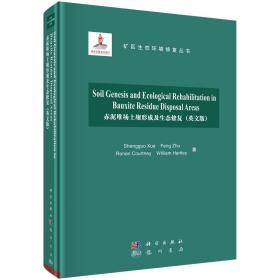
赤泥堆场土壤形成及生态修复(英文版)
全新正版 极速发货
¥ 166.58 6.7折 ¥ 249 全新
库存4件
作者薛生国 等
出版社龙门书局
ISBN9787508857800
出版时间2020-10
装帧精装
开本16开
定价249元
货号1202173823
上书时间2024-06-01
- 最新上架
商品详情
- 品相描述:全新
- 商品描述
-
目录
Chapter 1 Characterization and Disposal of Bauxite Residue 1
1.1 Introduction 1
1.2 Generation of Bauxite Residue 3
1.2.1 Bauxite Production and Global Reserves 3
1.2.2 Production Process of Alumina 4
1.2.3 Annual Production and Inventory of Bauxite Residue 6
1.3 Properties of Bauxite Residue 6
1.3.1 Physical Properties 6
1.3.2 Chemical Properties 7
1.3.3 Biological Properties 13
1.4 Management of Bauxite Residue 14
1.4.1 Conventional Disposal of Bauxite Residue 14
1.4.2 Utilization of Bauxite Residue 14
1.5 Alkalinity Transformation of Bauxite Residue 15
1.5.1 Alkaline Solid Transformation 15
1.5.2 Waste Acid Synergy 20
1.5.3 Acid Gas Sequestration 21
1.5.4 Chloride Salt Neutralization 24
1.6 Soil Formation and Revegetation of Bauxite Residue 26
1.6.1 Amelioration of Bauxite Residue 27
1.6.2 Screening of Tolerant Plant Species and Microorganisms 28
1.6.3 Soil Formation in Bauxite Residue 30
References 31
Chapter 2 Novel Predictors of Soil Genesis in Bauxite Residue under Natural Weathering Processes 38
2.1 Natural Evolution of Alkaline Characteristics in Bauxite Residue 38
2.1.1 Transformation of Basic Alkalinity 40
2.1.2 Transformation of Electrical Conductivity 42
2.1.3 Transformation of Exchangeable Cations 43
2.1.4 Transformation of Acid Neutralizing Capacity 45
2.1.5 Environmental Management for Long-Term Disposal 47
2.2 Natural Plant Colonization Improves Physical Conditions of Bauxite Residue 47
2.2.1 Particle Size Distribution 48
2.2.2 Bulk Density and Total Porosity 50
2.2.3 Mean Weight Diameter (MWD) and Water-Stable Aggregates (WSA) 51
2.2.4 Structural Stability Index (SI) 52
2.3 Development of Alkaline Electrochemical Characteristics 52
2.3.1 Mineralogy 53
2.3.2 Zeta Potential Curves and Isoelectric Point 56
2.3.3 Surface Protonation and Alkaline Group 58
2.4 Dynamic Development of Bacterial Community Diversity and Structure 60
2.4.1 Residue Properties 61
2.4.2 Diversity of Bacterial Community 62
2.4.3 Composition of Bacterial Community 63
2.4.4 Correlation between Bacterial Community and Residue Property 67
2.5 Novel Predictors of Soil Genesis in Bauxite Residue 69
2.5.1 Variation of Chemical Properties 70
2.5.2 Variation of Physical Properties 72
2.5.3 Effects on Aggregate Stability 73
2.5.4 Novel Predictors of Soil Genesis 76
References 78
Chapter 3 Aggregate Formation and Stability in Bauxite Residue Following Soil Genesis 87
3.1 Erosion Resistance of Water-Stable Aggregates in Bauxite Residue 87
3.1.1 Distribution of Aggregate Fractions and MWD by the Modified Yoder’s Method 87
3.1.2 Distribution of Aggregate Fractions and MWD by the Modified Le Bissonnais,Method 89
3.1.3 The Erodibility Factor (K) of Bauxite Residues 91
3.1.4 Variable Effectiveness of Mechanisms to Erosion of Bauxite Residue 93
3.2 Effects of Iron-Aluminum Oxides and Organic Carbon on Aggregate Stability 95
3.2.1 Iron-Aluminiim Oxide Contents and Their Relationship with Aggregate Stability 95
3.2.2 Aggregate-Associated Carbon and the Relationship with Aggregate Stability 97
3.2.3 Variation of Aggregate-Associated Organic Carbon Functional Groups 99
3.3 Fractal Features of Residue Microaggregates in Bauxite Residue Disposal Areas 101
3.3.1 Particle Size Distribution of Residue Microaggregates 102
3.3.2 Microaggregate Stability of the Residues 105
3.3.3 Single-Fractal Features of Residue Microaggregates 109
3.3.4 Multi-Fractal Dimension of Residue Microaggregates 111
3.3.5 Relationship between Microaggregate Stability and Fractal Parameters 114
3.4 Effects of Binding Materials on Micro-Aggregate Size Distribution in Bauxite Residues 115
3.4.1 Effect of Organic Matter 115
3.4.2 Effect of Carbonate on Residue Microaggregate Size Distribution 117
3.4.3 Effect of Electrolyte on Residue Microaggregate Size Distribution 118
3.4.4 Effect of Clay Mineralogy on Residue Microaggregate Size Distribution 120
3.4.5 Effect of Iron-Aluminum Oxides on Residue Microaggregate Size Distribution 121
3.5 Evaluation on Aggregate Microstructures Following Natural Regeneration 122
3.5.1 Residue Micromorphology 122
3.5.2 Visualization of Soil Aggregates 126
3.5.3 Porosity and Pore-Size Distribution 127
3.5.4 Shape Parameters in Residue Aggregates 128
3.5.5 Effects on Residue Aggregate Microstructure 130
3.6 Vermicompost and Gypsum Improve Aggregate Formation in Bauxite Residue 131
3.6.1 Residue Properties 132
3.6.2 Residue Macroaggregate Formation 134
3.6.3 Residue Microaggregate Formation 137
3.6.4 Residue Micromorphology 139
References 141
Chapter 4 Regulation on Saltinity and Alkalinity of Bauxite Residue Following Soil Genesis 149
4.1 Migration and Distribution of Saline Ions in Bauxite Residue during Water Leaching 149
4.1.1 Change of Saline Cation Concentration in Leachate 150
4.1.2 Change of Saline Anion Concentration in Leachate 150
4.1.3 Vertical Distribution of Saline Cations in Residue 151
4.1.4 Vertical Distribution of Saline Anion in Residue 153
4.1.5 Potential Implication for Revegetation 155
4.2 Leaching Optimization and Dissolution Behavior of Alkaline Anions in Bauxite Residue 155
4.2.1 Effect ofL/S Ratio 156
4.2.2 Effect of Leaching Temperature 158
4.2.3 Effect of Leaching Time 158
4.2.4 Orthogonal Experimental Analysis for Optimized Leaching Conditions 159
4.2.5 Dissolution Equilibrium of Multiple Leaching Stages 160
4.2.6 Leaching Kinetics of Critical Anions 162
4.3 Effect of Ammonium Chloride on leaching Behavior of Ions in Bauxite Residue …163
4.3.1 Effect of Ammonium Chloride Addition 164
4.3.2 Effect of L/S Ratio 166
4.3.3 Effect of Leaching Temperature 167
4.3.4 Effect of Leaching Time 169
4.3.5 Orthogonal Experimental Analysis for Optimized Regulating Conditions 170
4.3.6 Mineral and Morphology Characteristics 172
4.4 Acid Transformation of Bauxite Residue: Conversion of Its Alkaline Characteristics 174
4.4.1 Mineral Chemistry 175
4.4.2 Solution Chemistry 178
4.4.3 Morphology Characteristics 181
4.4.4 Implications for Bauxite Residue Disposal 183
4.5 Alkalinity Stabilization Behavior of Bauxite Residue Following Gypsum Regulation 184
4.5.1 Effect of Gypsum Addition 185
4.5.2 Effect of Stabilized Time 187
4.5.3 Effect of Stirring Strength 188
4.5.4 Behavior of Chemical Regulation 189
4.5.5 Behavior of Physical Immobilization 191
4.6 Phosphogypsum Stabilization of Bauxite Residue: Conversion of Its Alkaline Characteristics 193
4.6.1 The Influence of Phosphogypsum Quantity upon Bauxite Residue 194
4.6.2 Effect of Contact Time upon Interaction of Phosphogypsum and Bauxite Residue 196
4.6.3 Evaluation of Dissolution of Bauxite Residue 198
4.6.4 Mineral Phase and Morphology Characteristics 198
4.7 Organic Acid and Gypsum Improve Alkalinity Transformation of Bauxite Residue 201
4.7.1 Mineralogy 202
4.7.2 Isoelectric Point 203
4.7.3 Alkaline Group 205
4.7.4 Particle Micromorphology 205
4.7.5 Mineral Acids Addition 206
4.7.6 Organic Acid Addition 207
4.7.7 Gypsum Addition 208
4.7.8 Implications for Bauxite Residue Management 209
References 210
Chapter 5 Environmental Risk Assessment on Bauxite Residue Disposal Areas Following Soil Genesis 214
5.1 Regional-Scale Investigation of Salt Ion Distribution Characteristics in Bauxite Residue 214
5.1.1 Salt Composition in Bauxite Residue 215
5.1.2 Mineralogical Composition in Bauxite Residue 217
5.1.3 Correlation Analysis of Salt Ions in Bauxite Residue 217
5.1.4 Degree of Salinization and Alkalization in Bauxite Residue 219
5.2 Spatial Distribution of Soil Chemical Properties Around Bauxite Residue Disposal Area 221
5.2.1 Descriptive Statistics of Soil Surrounding BRDA 223
5.2.2 Chemical Compositions of the Bauxite Residue 224
5.2.3 Spatial Distribution of Heavy Metals, Salinity, and Alkalinity in Soils 225
5.2.4 Correlation Analysis 227
5.2.5 Potential Source Analysis of Chemicals in Soils 228
5.2.6 Assessment of Environmental Impact 230
5.3 Effect on the Leaching of Metals from Bauxite Residue 231
5.3.1 Properties of the Materials 233
5.3.2 Evaluation of NA and FS Neutralization 234
5.3.3 Effect of Ferrous Sulfate and Nitrohumic Acid on the Composition of Bauxite Residue 236
5.3.4 Changes of Metal Fractionation in Bauxite Residue 238
5.3.5 Leaching Property of Metals from Bauxite Residue 239
References 244
Chapter 6 Ecological Rehabilitation on Bauxite Residue Disposal Areas: Field Studies 247
6.1 Indicators of Soil Formation in Restored Bauxite Residues 247
6.1.1 Restoration Strategies on the Disposal Area 247
6.1.2 Changes on Properties of Bauxite Residue 248
6.1.3 Screening on Indicators of Soil Formation 251
6.2 An Evaluation of Revegetation Success on Bauxite Residue 254
6.2.1 Plant Diversity on the Resoted Bauxite Residue 255
6.2.2 Evaluation of Revegetation Success 259
6.3 Nematode Assemblages in Bauxite Residue with Different Restoration Histories 262
6.3.1 Soil Properties under Different Bauxite Treatments 263
6.3.2 Nematode Assemblages 264
6.3.3 Relationships between Soil and Nematode Assemblage Properties 266
6.4 Macro-Arthropod Succession in Grassland Growing on Bauxite Residue 269
6.4.1 Arthropods and Soi
相关推荐
-

赤泥堆场土壤形成及生态修复:英文版
全新保定
¥ 164.10
-

赤泥堆场土壤形成及生态修复(英文版)
全新广州
¥ 168.58
-

赤泥堆场土壤形成及生态修复(英文版)
全新广州
¥ 166.58
-

赤泥堆场土壤形成及生态修复(英文版)
全新广州
¥ 168.58
-

赤泥堆场土壤形成及生态修复(英文版)
全新广州
¥ 168.58
-

赤泥堆场土壤形成及生态修复(英文版)
全新成都
¥ 155.28
-

赤泥堆场土壤形成及生态修复:英文版
全新广州
¥ 164.34
-

赤泥堆场土壤形成及生态修复(英文版)
全新南京
¥ 179.28
-

赤泥堆场土壤形成及生态修复(英文版)
全新成都
¥ 196.70
-

赤泥堆场土壤形成及生态修复(英文版)
全新成都
¥ 174.30
— 没有更多了 —












以下为对购买帮助不大的评价